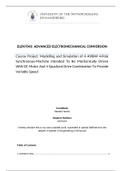Summary
Summary In this assessment, you ll develop an intervention as a solution to the health problem youve defined. To prepare for the assessment, think about an appropriate intervention, based on your work in the preceding assessments, that will produce tangible, meas
- Course
- ACC 201
- Institution
- Southern New Hampshire University
In this assessment, you ll develop an intervention as a solution to the health problem youve defined. To prepare for the assessment, think about an appropriate intervention, based on your work in the preceding assessments, that will produce tangible, measurable results for the patient, family, or g...
[Show more]












